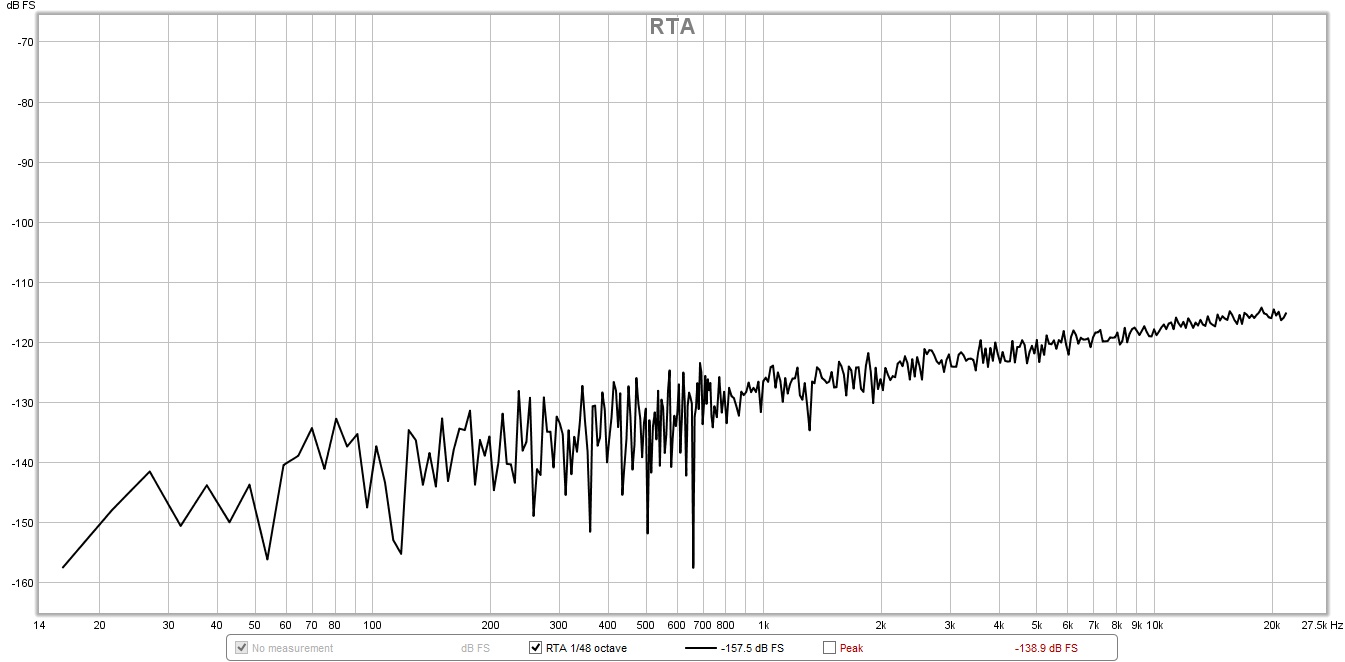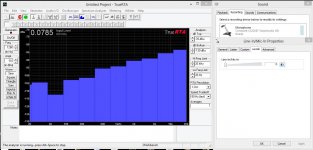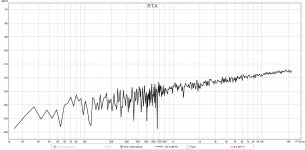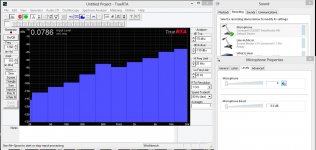This could be my baby steps for measuring stuffs I build.
Just bought a creative USB sound card.
presently I am on Toshiba laptop with i5 processor and 6gb Ram
Please notice the Graph from RTA.
Why is it slanted,I mean why is the frequency response not flat?Last snap is of onboard sound card which connexant HD and it is no different either.
Surprisingly Why do I see different readings from both the apps ? one is around TRTA85db while other REW is 110db. I am trying with demo spectra plus as well which looks much better.
Meanwhile the inputs are mute.
Regards
Just bought a creative USB sound card.
presently I am on Toshiba laptop with i5 processor and 6gb Ram
Please notice the Graph from RTA.
Why is it slanted,I mean why is the frequency response not flat?Last snap is of onboard sound card which connexant HD and it is no different either.
Surprisingly Why do I see different readings from both the apps ? one is around TRTA85db while other REW is 110db. I am trying with demo spectra plus as well which looks much better.
Meanwhile the inputs are mute.
Regards
Attachments
Hi Sy,
How do I make it flat to measure a preamplifier ?
Also the specs shows that SNR of the said sound card is 100db minimum.how far it could be true?
Any suggestions for a reliable straightforward measurement PC analysers ?
Is selecting DBfs proper ? the vertical dbu scale in Rew confused me.
How do I make it flat to measure a preamplifier ?
Also the specs shows that SNR of the said sound card is 100db minimum.how far it could be true?
Any suggestions for a reliable straightforward measurement PC analysers ?
Is selecting DBfs proper ? the vertical dbu scale in Rew confused me.
Last edited:
Hi,
Funny, same problem to me, i sucess to have my first spectrum analys :
behringer ECM-8000 (non calibrate)
ARTA (free one)
E-MU Pre tracker Pro USB soundcard with Phantom alim to 48v from USB port (class A pre)
The Pink-noise .wav is send from my digital source with a reccording from Audiocheck.net.
Well, without noise in the room the curve is like a : W
I don't waiting for flat in the bass cause the room, but after 1000 hz with the micro in front of the speaker (50 cm), I would waiting for a flater curve without sound ! So after sending pink noise and freeze the curve... how to read a false curve !
Calibration ? Function in ARTA to flatthe curve before measure ?
Jayadev, the first who finds call the other
Funny, same problem to me, i sucess to have my first spectrum analys :
behringer ECM-8000 (non calibrate)
ARTA (free one)
E-MU Pre tracker Pro USB soundcard with Phantom alim to 48v from USB port (class A pre)
The Pink-noise .wav is send from my digital source with a reccording from Audiocheck.net.
Well, without noise in the room the curve is like a : W
I don't waiting for flat in the bass cause the room, but after 1000 hz with the micro in front of the speaker (50 cm), I would waiting for a flater curve without sound ! So after sending pink noise and freeze the curve... how to read a false curve !
Calibration ? Function in ARTA to flatthe curve before measure ?
Jayadev, the first who finds call the other
Hi Sy,
Don't ! Not yet please ... we have Jayadev and I to dig a little to find by ourselves... After all two days ago i was looking for how to take a measure and just suceess yesterday !
... we have Jayadev and I to dig a little to find by ourselves... After all two days ago i was looking for how to take a measure and just suceess yesterday !
If in one week i don't find after reading the ressources here and elswhere, i will send a big Heeeeeeeeeeelp !
Have a nice day Sy,
eldam
Don't ! Not yet please
If in one week i don't find after reading the ressources here and elswhere, i will send a big Heeeeeeeeeeelp !
Have a nice day Sy,
eldam
What bothers you guys is the non linearity of the spectrum. What surprises me is that with the mic (or line in) muted I have ups and downs in the spectrum line within +-10dB. I see on the picture of jayadev even up to 30dB curls. The question that rises is how it is possible to make decent spectral measurement with such a poor setup? It is such a mess even when no signal is applied...
Will be waiting .I'll try to remember to compose a decent reply later today when I'm not rushed.
I am still in wonderment why they give Dbfs for an analogue audio analyse.
Pirat of Carabians: RTA & ARTA are goods softwares...don't think it's the softs but the lake of method from us !
Without injecting signal with soundcard or rec with its digital source : what is a normal curve with such equipment in a room if not flat?
Is it noise of the pre sound card or/and non calibrating correction curve of the mic applied in the soft ?
Without injecting signal with soundcard or rec with its digital source : what is a normal curve with such equipment in a room if not flat?
Is it noise of the pre sound card or/and non calibrating correction curve of the mic applied in the soft ?
After enter Generic calibration file for my micro, it is better above 1K :
first picture : silent room
second picture : pink noise, mic at half one meter between tweeter and medium
FS: 192 khz ; FFT : 65536 ; Wnd : Hanning....
a little dig at 2khz and a little bump at 8 khz... can I believe that ? Or do i have to change the ASCII calibration file to make the curve without sound flater ?
first picture : silent room
second picture : pink noise, mic at half one meter between tweeter and medium
FS: 192 khz ; FFT : 65536 ; Wnd : Hanning....
a little dig at 2khz and a little bump at 8 khz... can I believe that ? Or do i have to change the ASCII calibration file to make the curve without sound flater ?
Attachments
Last edited:
I just started getting into these test softwares recently so have NIL knowledge about them right now. But found that most of online test websites mostly use RightMark. And AFAIK you can feed the line-in and mic in RMAA too. I also downloaded free version of RMAA and was just playing with it.Pirat of Carabians: RTA & ARTA are goods softwares...don't think it's the softs but the lake of method from us !
Without injecting signal with soundcard or rec with its digital source : what is a normal curve with such equipment in a room if not flat?
Is it noise of the pre sound card or/and non calibrating correction curve of the mic applied in the soft ?
Last edited:
What I actually want to know is
1.Do I need to use the calibration file to make it flat.
2.Is there some inherent problem with my computer or sound card for being too much noisy in HF octaves? Indicating for an immediate upgrade to better sound card or Pc.
If former is the answer then I have no more doubts on this matter.
Experts Please advice.
1.Do I need to use the calibration file to make it flat.
2.Is there some inherent problem with my computer or sound card for being too much noisy in HF octaves? Indicating for an immediate upgrade to better sound card or Pc.
If former is the answer then I have no more doubts on this matter.
Experts Please advice.
I just started getting into these test softwares recently so have NIL knowledge about them right now. But found that most of online test websites mostly use RightMark. And AFAIK you can feed the line-in and mic in RMAA too. I also downloaded free version of RMAA and was just playing with it.
thank you JS for input, I have to try it too if free.
I have great pain to have a flat curve with my mic and it's worse below 2K with our without generic calibrated file.
As I think my USB pre tracker pro is enough for Spectrum analys, I fear that I need a calib mic.
A question in complement to OP : in a home room, can we expect to have a +/- 2 DB curve above 100 hz ?
Maybe a link or a forum for the art in home acoustic measurement will be pleasse very helpfull if exist.
thanks
Eldam
Impulse response measurement with swept sine is much better way to measure, be it gear, speakers, or room interaction.
Generic measurement microphones are typically very flat from 50Hz-4kHz, some up to about 7kHz. High quality measurement microphones are often flat from below 10Hz to >20kHz.
Sound Blaster X-Fi is likely very flat to below 15Hz; noise floor below 16bits, and distortion <0.008%.
Many multiple channel sound cards may be used as active crossover and equalization platform when used with convolution engine implemented on computer.
Generic measurement microphones are typically very flat from 50Hz-4kHz, some up to about 7kHz. High quality measurement microphones are often flat from below 10Hz to >20kHz.
Sound Blaster X-Fi is likely very flat to below 15Hz; noise floor below 16bits, and distortion <0.008%.
Many multiple channel sound cards may be used as active crossover and equalization platform when used with convolution engine implemented on computer.
How do you impuse Swept sine ?
Yajadev : http://www.diyaudio.com/forums/mult...onse-completed-loudspeaker-home-accuracy.html
experts point of view...
And finaly a question that maybe has be posted many times : is it possible to measure its room in a relative silent mode to calibrate its own sound cards + mic for a flat response (assuming +/- 2 DB is a good flat curve for ears). I have a doubt about the OP want to measure its soundcard or own mic. They are just a part of the problem... no ?
Yajadev : http://www.diyaudio.com/forums/mult...onse-completed-loudspeaker-home-accuracy.html
experts point of view...
And finaly a question that maybe has be posted many times : is it possible to measure its room in a relative silent mode to calibrate its own sound cards + mic for a flat response (assuming +/- 2 DB is a good flat curve for ears). I have a doubt about the OP want to measure its soundcard or own mic. They are just a part of the problem... no ?
Last edited:
Nope, Input is at 0 with no signal.
In OP result:

Looks like source signal was white noise instead of pink using RTA 1/48 octave. For this mode use pink noise. For spectrum mode use white noise.
- Status
- This old topic is closed. If you want to reopen this topic, contact a moderator using the "Report Post" button.
- Home
- Source & Line
- PC Based
- RTA measurements and soundcard


